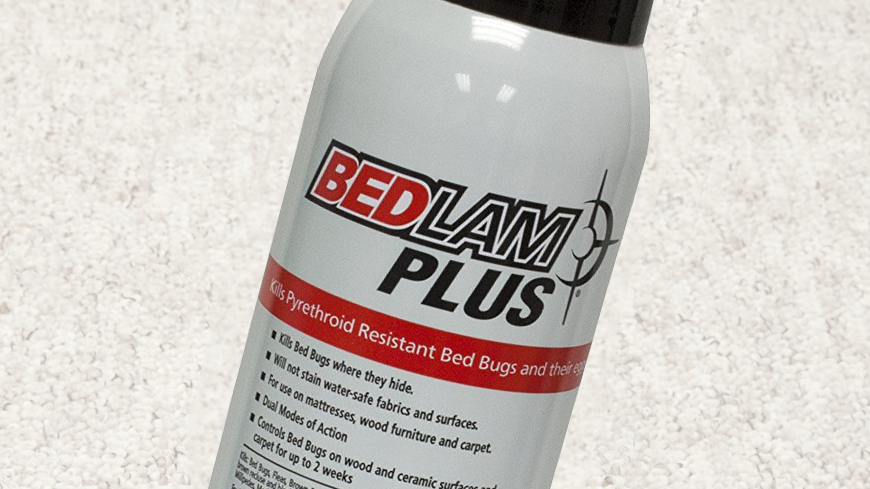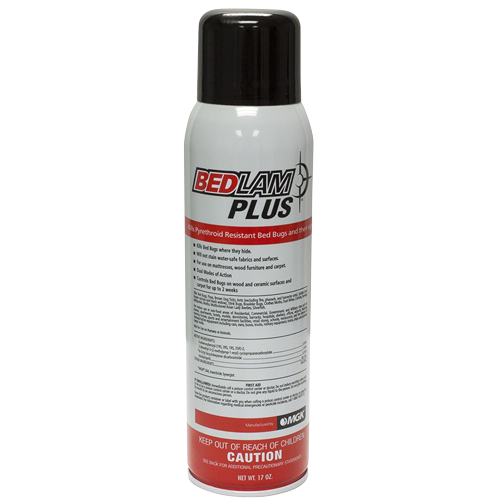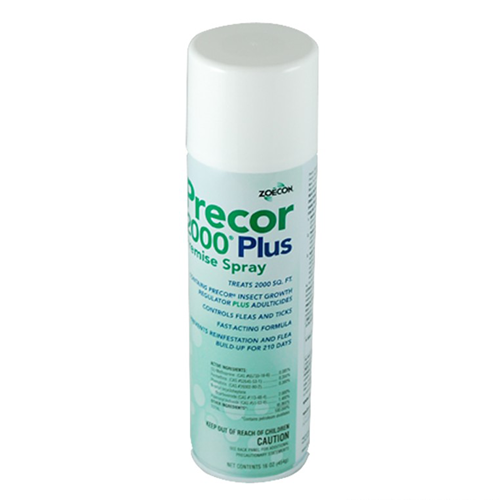Summary
Bedlam Plus is an aerosol insecticide primarily used to kill bed bugs, but it also kills fleas and other insect pests. It contains two adulticides, phenothrin and imidacloprid. These two insecticides belong to different classes, so resistance to both is unlikely.
Bedlam Plus may be a good choice for bed bug control, but not for fleas. Bedlam Plus lacks an insect growth regulator to provide long-lasting control in hard-to-treat areas, which is important when fighting fleas. Precor 2000 Plus is a good, relatively inexpensive flea premise spray.
| Product name | Bedlam Plus |
| Active ingredients | 0.40% phenothrin 0.05% imidacloprid 1.00% MGK 264 98.55% other ingredients |
| Target pest | Bed bugs, fleas, ticks, dust mites, moths, & carpet beetles |
| Kills | Adults, eggs & larvae |
| Duration | 2 weeks |
| Size | 17 ounces |
| Capacity | n/a |
| Application | Aerosol spray |
| Use on | Mattresses, furniture, & carpet |
| Manufacturer | MGK |
| UPC | 848920000553 |
| Product label | view |
| MSDS | view |
| Shop | Amazon.com |
| Price | $18 |
| Customer reviews | Read reviews |
| Competitors | Browse premise sprays |
- Prices are based on Amazon.com at time of publishing.
Details
How Bedlam Plus Works
Phenothrin
Phenothrin is a pyrethroid insecticide. Pyrethroids are synthetic derivatives of pyrethrum, a botanical insecticide found in chrysanthemum flowers. These compounds quickly kill adult insects by affecting their nervous system. The main benefit of pyrethroids is that they’re designed to be more chemically stable than pyrethrum.
Phenothrin will kill adult fleas in the environment. However, only 1-5% of a flea population is in the adult stage. Plus, most adult fleas live permanently on their host. As a result, few emerged adults will be found in the environment at any given time.
95-99% of flea populations are eggs, larvae, and pupae living in the environment. Unfortunately, these stages develop within protected refuges where sprays and vacuums can’t penetrate (e.g. base of carpets). So, many immature stages present at the time of spraying won’t be affected and will eventually emerge as adults. Adding to this, phenothrin and other adulticides have a short-lived effect. Insect growth regulators (IGR) are a better choice for environmental flea control because they last for 7 months indoors. This is why Bedlam Plus isn’t the best choice for fleas.
Imidacloprid
Imidacloprid (IMI) is another adulticide included in Bedlam Plus. It is a neonicotinoid insecticide which affects the central nervous system of insects. This class of compounds is similar in structure to nicotine, but neonicotinoids are designed to specifically target insect receptors.
IMI is included in Bedlam Plus for redundancy. It will ensure that exposed insects die even if they’ve developed resistance to pyrethroids (phenothrin).
MGK 264
N-octyl bicycloheptene dicarboximide (MGK 264) is a synergist found within Bedlam Plus. Synergists aren’t insecticides, but instead work to boost the efficacy of pyrethrins and pyrethroids. As a result, less insecticide is needed, which leads to cost savings and improved safety.
Precor 2000 Plus
Precor 2000 Plus contains an IGR and is better for flea control.
Competitor Comparison
Bedlam Plus isn’t the best premise spray for flea control, because it doesn’t contain an IGR. IGRs work well against fleas because they last 7 months, which makes controlling hard-to-treat easier. Most fleas develop in carpets, and sprays can’t penetrate well. However, since IGRs last so long, new eggs that fall onto the treated surfaces won’t survive. The generation present at the time of spraying will be the last. Precor 2000 Plus is among the best choices for flea premise sprays.
Instructions
The following instructions were taken from the Bedlam Plus product label. Before using the product, view the label for the full directions and precautionary statements.
- Kills Bed Bugs where they hide
- Will not stain water-safe fabrics and surfaces
- For use on mattresses, wood furniture and carpet
- Dual Modes of Action
- Controls Bed Bugs on wood and ceramic surfaces and carpet for up to 2 weeks
DIRECTIONS FOR USE
It is a violation of Federal law to use this product in a manner inconsistent with its labeling.
USE RESTRICTIONS:
- This product is not for use on humans or animals.
- In hospitals and nursing homes, remove patients from immediate area to be treated. Allow surfaces to dry before reoccupying.
- Do not use in commercial food/feed processing, preparation, food/feed storage or serving areas.
- In the home, all food/feed processing surfaces and utensils should be covered during treatment, or thoroughly washed before use. Exposed food/feed should be covered or removed.
- Remove pets, birds and cover fish aquariums before spraying.
- Do not apply to furniture or upholstery where prolonged contact with humans will occur.
- Do not apply to bed linens or other materials that come in direct contact with occupants of the bed.
SHAKE WELL BEFORE EACH USE.
APPLICATION:
Use as an indoor spot spray or crack and crevice treatment. Spray in an inconspicuous area to test for possible staining. Evaluate test area after drying. Hold container upright with nozzle aimed away from you. Depress valve and spray from a distance of 8 to 10 inches. Spray each square foot until damp. Use the straw applicator for crack and crevice treatment. Allow sprayed articles and surfaces to dry thoroughly before using. Do not allow children or pets to contact treated areas until surfaces are dry.
TO KILL CRAWLING INSECTS:
Apply as a spot or crack and crevice treatment where insects are harboring, traveling, or breeding. Treat interior entry points such as around windows, doors, and water pipes. Also treat feeding or hiding areas such as baseboards, carpet, floor, rugs, under refrigerators, cabinets, sinks, and stoves.
TO KILL BED BUGS AND BED BUG EGGS:
For infested mattresses, remove linens and wash before reuse. Apply to tufts, folds, edges, sides and seams until damp. Allow to dry before reuse. Apply on and around baseboards, carpet, rugs, bed frames, box springs, headboards, wheelchairs, closets, wall hangings, furniture, seats, moldings, picture frames, ceiling, drapes, luggage, and walls. Spray bed bugs and eggs directly whenever possible. Use attached straw applicator for crack and crevice treatments.
TO KILL BROWN DOG TICKS AND FLEAS:
Spray on and around beds, furniture and pet’s habitat. Spray pet sleeping quarters, bedding, carpeting, floor and floor covering where pets are kept. Use only a recommended pet spray on pets.
TO KILL DUST MITES:
Thoroughly vacuum entire room concentrating on areas where mites congregate such as mattresses, box springs, headboards, walls, floors, carpeting, and baseboards. Spray surfaces until damp. Allow to dry before reuse
TO KILL CLOTHES MOTHS AND CARPET BEETLES:
Apply as a spot treatment to cracks and crevices on and around baseboards, floorboards, furniture and around the edges of carpet. Apply to carpet, rugs, closets, baseboards, furniture, on floor and floor coverings. When treating carpets, floor coverings or rugs, spray a sufficient amount to get the spray down into the base where the larval stages are feeding. Spray upper and lower surfaces of rugs or floor covering when possible.
STORAGE AND DISPOSAL
Do not contaminate water, food, or feed by storage and disposal.
PESTICIDE STORAGE:
Store in a cool, dry area. Always store pesticides in the original container. Store away from food and pet food.
PESTICIDE DISPOSAL AND CONTAINER HANDLING:
Do not puncture or incinerate! Non-refillable container. Do not reuse or refill this container.
If empty: Place in trash or offer for recycling if available.
If partly filled: Call your local solid waste agency for disposal instructions.
Tips for Success
Use an IGR
If you’re fighting fleas, use a premise spray containing an insect growth regulator. Look for the active ingredients pyriproxyfen (Nylar) or methoprene (Precor). View our list of top flea premise sprays for more information.
Target Hot-Spots
Flea eggs are laid on the host, but they aren’t sticky and soon fall off. Eggs can drop wherever the animal roams, but most end up in favored resting spots. Hot-spots tend to occur where pets sleep, eat, and groom. In bedrooms, flea-prone areas tend to be beside the bed. In living rooms, hot-spots develop near pet bedding or beside seating.
When spraying, be thorough and treat the entire floor. However, give special attention to where flea hot-spots are probable. If follow-up treatments are necessary, spraying can be limited to the identified hot-spots.
Have Realistic Expectations
Fighting fleas is frustrating, but having proper expectations can ease the stress. There isn’t a product or method that can end an infestation immediately. Patience is required. This is because many immature stages live deep within carpets or other substrates. There, they are protected against vacuum removal and insecticide penetration. Before fleas are extinct in the home, these young stages need to mature, emerge, and die. This usually takes around 8 weeks.
If an IGR is used, new eggs that fall onto the floors won’t survive. However, many immature fleas already in the environment may be unaffected. In time, they will emerge as the last adults. Thus, it’s normal to see new adult fleas here or there after spraying. This can make it seem like the spray didn’t work, but it should be the last generation of adults.
Pre-Emerged Adults
Pre-emerged adult fleas can cause control issues. After pupating, some adults may stay inside their cocoon. There, they can enter into a quiescent state for up to 5 months. However, they’ll quickly wake up and emerge upon detecting a host on the cocoon (heat and pressure). Vacuuming can simulate these host cues and force earlier emergence.
Vacuuming Procedure
Vacuum carpets before spraying an insecticide. Vacuuming lifts up the carpet fibers so the spray can penetrate deeper. Don’t vacuum again until the spray completely dries. Then begin vacuuming every other day. Studies have shown that dry vacuuming shouldn’t affect flea insecticides. It may actually improve efficacy by causing adults to emerge from their cocoons into the insecticide.
Premise Sprays Aren’t Enough
Adult fleas only account for 1-5% of infestations. Most live on pets and won’t leave of their own volition. If pets aren’t treated, the adult fleas will continue to thrive. Each female flea lays about 25 eggs a day. The eggs drop wherever the host roams. If eggs fall onto an untreated surface, then the infestation will continue.
This is why integrated flea control is the best approach. Treat the environment, treat pets, and establish a regular vacuuming routine. This kind of regime will establish control quickly, and maintaining control will be easy until full eradication.







You must log in to post a comment. Log in now.